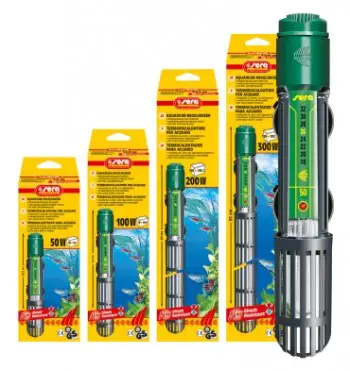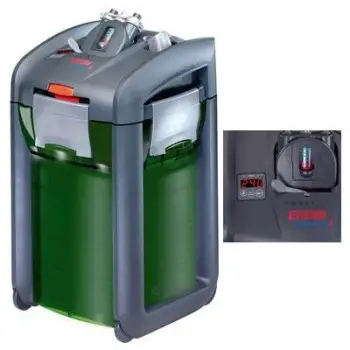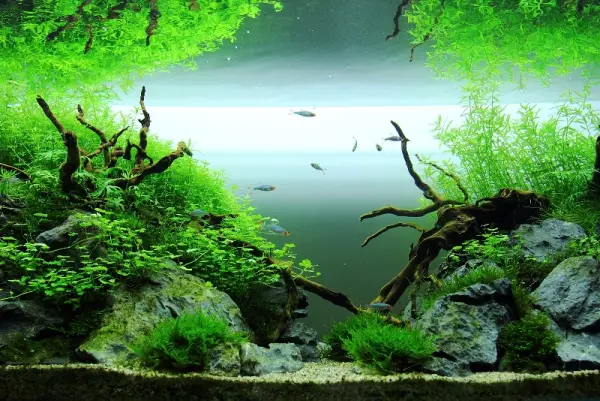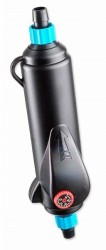Heating the Aquarium
What are the basic ways of heating an aquarium?
Along with filtration, heating is among the most important considerations for fishkeepers. The majority of freshwater species that we keep in our aquaria are found geographically in the area between the Tropic of Cancer and the Tropic of Capricorn (23° north and south of the equator respectively), hence the term ‘the tropics’ and therefore ‘tropical fish’.
Ambient temperatures in the tropics rarely fall much below 68°F/20°C, at least for any sustained length of time. Additionally temperatures in the tropics have little seasonal variation.
Even in a modern, centrally heated home, temperatures regularly fall below this minimum level in many countries, meaning that to keep successfully any tropical fish species a heater is required.
What do fish prefer?
When considering heating requirements, it is important to think about the fish you intend to keep. If your intention is a general community tank with a variety of fish, then the required temperature will always be a compromise that suits all the different species you plan on having in your tank.
In general, the majority of commonly available community species will be perfectly happy in a tank where the temperature is somewhere between 70 – 82°F/21 – 28°C.
If you intend to keep a particular species or group of fish then it is good practice to aim for a temperature as close as possible to that which the species would live in naturally.
For example, some species do best at temperatures in excess of 30°C/86°F while others prefer cooler temperatures of 20°C/68°F or less but all are traded as suitable for the ‘tropical’ aquarium.
It is advisable to research the requirements of individual fish when planning your overall setup. Many species will tolerate temperatures outside their natural range, but the aim should always be to replicate the conditions they would experience in the wild as it is only then that they will thrive.
Equipment
A vital complement to a heater is a proper thermometer but avoid the ‘stick-on-the-glass’ type since these are easily influenced by ambient temperature. Simple, submersible, glass aquarium thermometer are cheap to buy, accurate and sufficient for the needs of most fishkeepers.
In terms of heating equipment there are a number of options available, and we’ll consider each in turn.
Heater/Thermostat
The combined heater/thermostat is the near universal piece of equipment that most aquarists use to heat their aquaria. The heaterstat, as it is commonly known, is an automatic device that measures the temperature of the aquarium and turns the heater on and off, as required, until the desired temperature is achieved.
 Most heaterstats come with a dial that can be used to select the desired temperature. Heaterstats are available in numerous sizes and wattages and are therefore suitable for the majority of standard sized aquaria. The wattage of the heater should be equivalent to or slightly more than the aquarium volume in litres.
Most heaterstats come with a dial that can be used to select the desired temperature. Heaterstats are available in numerous sizes and wattages and are therefore suitable for the majority of standard sized aquaria. The wattage of the heater should be equivalent to or slightly more than the aquarium volume in litres.
With larger tanks, it is good practice to use two or more heaters as this facilitates a more even heat distribution and also provides a back up should one heater fail. This could also be considered for smaller tanks, for example you may wish to consider having two 150w heaters in your 48″ tank.
This also reduces the risk of your fish being killed if a heater sticks in the “on” position, as it would take longer for the tank to reach life-threatening temperature levels.
When using a heaterstat for the first time (or if you are using a unit that has been out of the water for some time) it’s a good idea to check how accurate the temperature scale is and to test i that it’s working properly.
Fill a (preferably plastic) bucket and install the heater using the suction cups to attach it. Select a temperature value around the middle of the range covered (77°F/25 degrees °C, for example) and leave the unit for a few hours before checking the temperature with a thermometer.
Heaterstats normally have a minimum water-level marked on them, and the unit may crack or fail completely if exposed below this recommendation. Some models now come with an automatic cut-off system but this should not be replied upon as a failsafe.
When doing any kind of maintenance that involves removing the heater or dropping the water below the recemmended minimum level always unplug the unit and leave it to cool for 30 minutes.
For very small aquaria there are also mini-units in the 7.5-25 watts range. Most of these do not feature an adjustable thermostat but are fixed at 77°F/25 degrees °C, and build quality, particularly the internal thermostats, can be somewhat unreliable.
A relatively recent development in heating technology has been the in-line heaterstat. This device functions in much the same way as described above but the main difference is that the unit sits outside the tank.
This heater can only be used where you have an external filter as it is designed in such a way that the output from your filter is directed through the in-line heater and back into the tank. The inline heaterstat is a sealed unit with a connector for the water input hose at one end and a connector at the other end to attach a hose to direct the water back to the aquarium.
This type of heater, although more expensive than a standard heaterstat, is an excellent idea if you have large fish such as cichlids and catfish that may attack or otherwise damage any internal equipment.
Thermofilter
 Thermofilters are similar to inline heaters in that they remove the actual heating unit from inside the aquarium. As the name suggests, thermofilters combine the heater and the filter into one piece of equipment – in this case, an external filter.
Thermofilters are similar to inline heaters in that they remove the actual heating unit from inside the aquarium. As the name suggests, thermofilters combine the heater and the filter into one piece of equipment – in this case, an external filter.
Eheim are the main manufacturers of this type of heater/filter, although some other companies are starting to follow suit. In this arrangement, the heating element is built into the filter and water is heated as it passes through the device.
There is a separate temperature probe which is placed into the tank and connected to the heater via a wire. Temperature can be adjusted via a control panel. As with inline filters, thermofilters are a good way of removing as much equipment as possible from the tank.
The disadvantage of thermofilters is that they cost considerably more than purchasing a heater and a filter separately. Additionally, if you are running a marine tank, you must ensure you purchase a model that is compatible with saltwater.
Space Heating
 The final option we will consider is space heating. This solution is only suitable for the fishkeeper with several tanks in a single room or shed and is unlikely to prove cost effective unless there are at least a dozen tanks present, depending on the space.
The final option we will consider is space heating. This solution is only suitable for the fishkeeper with several tanks in a single room or shed and is unlikely to prove cost effective unless there are at least a dozen tanks present, depending on the space.
Rather than heat each tank individually, space heating involves heating the whole area. This can be achieved in a number of ways but the best way to heat the room is by using a thermostatically controlled electric heater such as an oil-filled radiator or an electric fan heater.
This can potentially be a very expensive way of heating your tanks, so it is imperative that the room in which they are situated is very well insulated. Materials such as Kingspan, industrial grade polystyrene, cavity boards and Airtech insulation are all good options.
Consideration should also be given to covering any windows in the room or shed, although double glazing will help mitigate this. The disadvantage of space heating is that all tanks are maintained at the same temperature. One way round this is to heat the room to the minimum temperature required and then place a heaterstat in any tanks requiring a higher temperature.
What should I do if my heater fails?
In many cases there is no need for immediate panic. A tank in the average modern home will lose heat very slowly and many fish species can handle a gradual drop in temperature without problems (in some it may even trigger spawning!).
If you do keep sensitive or heat-loving species it can be a good idea to have a spare heater in stock just in case, however. If a power outage lasts longer than a few hours it’s a good idea to wrap the tank in insulating material; plastic bubble wrap or even blankets work well.
Any other tips?
Heaterstats can be unsightly devices that can spoil the visual effect of a carefully aquascapes aquarium. If unprepared to buy a more expensive inline device you can camouflage your unit by planting around it or placing some wood or other décor in front of it.
Ensure that there is sufficient water movement around the unit, and if planting closely or stocking fishes that like to hide it’s important to install a heater guard to prevent them being burned.
Many thanks to Jeroen Wijnands for comments and additions and Steven Gielis for suggestions.
Category: Articles, Beginner's Guide | Tags: aquarium, heater, heaterstat | 11 comments »




November 1st, 2012 at 9:45 am
I think there’s a few things missing here.
A vital companion for a heater is a proper thermometer. Avoid the stick on the glass type, these are easily influenced by ambient temperature. A simple glass aquarium thermometer can be found cheaply and is good enough for most fish keepers.
Heater/thermostats always have a minimum water level marked on the side. If the water gets lower than this the heater may fail or even crack. Some models now come with an automatic cut-off but do not count on this. When doing any kind of maintenance that involves removing the heater or dropping the water level below the acceptable minimum for the heater always unplug the unit and leave it to cool for 30 minutes.
When you buy a new heater and especially if you buy a used heater it’s a good idea to check how accurate the temperature scale is on the thermostat and to test it’s working properly. Fill a (preferably plastic) bucket and install the heater with the suction cups on the side of the bucket. Set the unit for the middle of the temperature range (usually 25 degrees celcius) and leave for several hours after which you check with your thermometer.
For very small tanks there’s small heaters in the 7.5-25 watts range. Most of these do not feature an adjustable thermostat but are fixed on 25 degrees C. Quality control isn’t always the best on these units so check before you install these in a tank. There’s quite a few stories on the internet of these models cooking fish because the thermostat malfunctions.
Heater or power failure is often no cause for immediate panic. A tank in the average living room will loose heat very slowly and many tropical species can handle a 4-5 degree gradual drop in temperature without problems (on some it may even trigger spawning). If you do keep sensitive or heat loving species it can be a good idea to have a spare heater in stock just in case. When a power outage lasts longer than a few hours it’s a good idea to wrap the tank in insulating material. Bubble wrap or even blankets will work well.
Heaters can be unsightly devices that visually spoil a carefully crafted tank. If you are not prepared to buy a more expensive inline unit you can camouflage the heater by planting around it or placing some wood in front of it. Do ensure that there is sufficient flow of water around the heater. When planting closely or if you have fish that like to hide it’s important to use a heater guard to prevent direct contact between the fish/plant and the heater because they can be burned.
November 1st, 2012 at 11:58 am
Really great post, thanks wijnands. This is exactly how we hoped the comments sections on articles like this one would be used.:)
Would you consider allowing us to incorporate some of this into the piece itself?
November 1st, 2012 at 12:08 pm
Thanks Matt. I like writing. Sure, go ahead, as long as you give credit 🙂
November 2nd, 2012 at 9:24 am
Cool, I’ll send you an email just now. 🙂
November 6th, 2012 at 12:54 pm
Again a nice article!
One remark though: I don’t like to read that the recommended temperature for discus fish (Symphysodon spp.) is 30°C or higher.
I always recommend a temperature around 28 degrees. I know almost everyone who keeps and/or breeds discus fish swore by a higher temperature.
I believe this is based on misinterpretation and greed.
First, the greed part:
Everyone knows fish grow faster at a higher temperature. And professional breeders want to sell as fast and as much as possible. Amateurs mostly copy this advice without knowing better.
Feeding discus mainly a meaty diet is also a mistake made with the intend to maximal growth but that would bring us off topic.
Second, the misinterpretation:
Measuring the temperature off a natural habitat goes a lot further than sticking a thermometer into the water in which you just captured a discus fish or any fish for that matter.
It is true that the surface temperature of most of the lakes throughout the distribution of discus is around 30 degrees or more depending on the season. But most lakes have strong temperature stratification.
If you would measure the temperature on the bottom off the lakes you would measure 25 to 26 degrees. And if you would measure on the depth were you could actually find discus the temperature will be around 28 degrees!
I am almost certain several fish species are kept to warm based on this inaccurate measurements!
Keeping fish to warm has several disadvantages. Just to name a few: shorter life expectancy, too fast growth often resulting in misgrowth and infertility.
For more information/sources:
http://famu.org/mayfly/pubs/pub_r/pubreissf1977p203.pdf
http://www.scielo.br/scielo.php?pid=S1679-62252008000400008&script=sci_arttext&tlng=pt
November 6th, 2012 at 2:04 pm
Hi SGielis, couldn’t agree more, in fact I’m unsure if keeping fish at a constant temperature is particularly good for them either given the diurnal variation they experience in nature.
There’s another article in there somewhere, but for now I’ll amend the comment about discus above.
Thanks a lot for the comments and feedback, keep them coming guys!
November 7th, 2012 at 1:15 pm
Quote SGielis: ” I am almost certain several fish species are kept too warm ……….
I’d go a step further and say: “I am absolutely certain that the majority of fish species are kept too warm.” And this results in a significantly shortened life expectancy.
I maintain all species I keep at the lowest level of recommended temperatures or distinctly below. Temps rise automatically in summer giving each species the right conditions for reproduction.
November 7th, 2012 at 1:21 pm
Hi Matt,
that “other article” could perhaps be about the many “too much” in fish keeping. Too much heat, too much food, too much light, too much sterility ……………..
Regards
R.
November 8th, 2012 at 7:50 pm
Hi Rudi, that’s a pretty good idea!
March 25th, 2013 at 3:28 am
Alright, I’ll look into it. I noticed today that my Zebra Fishes’ thermometer is below the green mark. They are in a 2.5 gallon tank though, and we did a tube or glass heater …in there for my Betta though he didn’t make a bubble nest. We took it out for him and he was good with out it..but now that the Zebra’s are in there…should i put the heater at 70 and leave it??? also how would I manage to make it heat the whole tank..not just one side.
March 25th, 2013 at 8:39 am
When you say “zebra fishes” I assume you’re talking about Danio rerio!? If that is correct, you’d have to worry rather about your “Betta”, which I assume is B. splendens. D. rerio is certainly comfortable with temperatures quite a bit lower than those generally recommended for B. Splendens.
I dare not assume however, what temperarure the “green mark” on your thermometer equates too.
Regards
R.